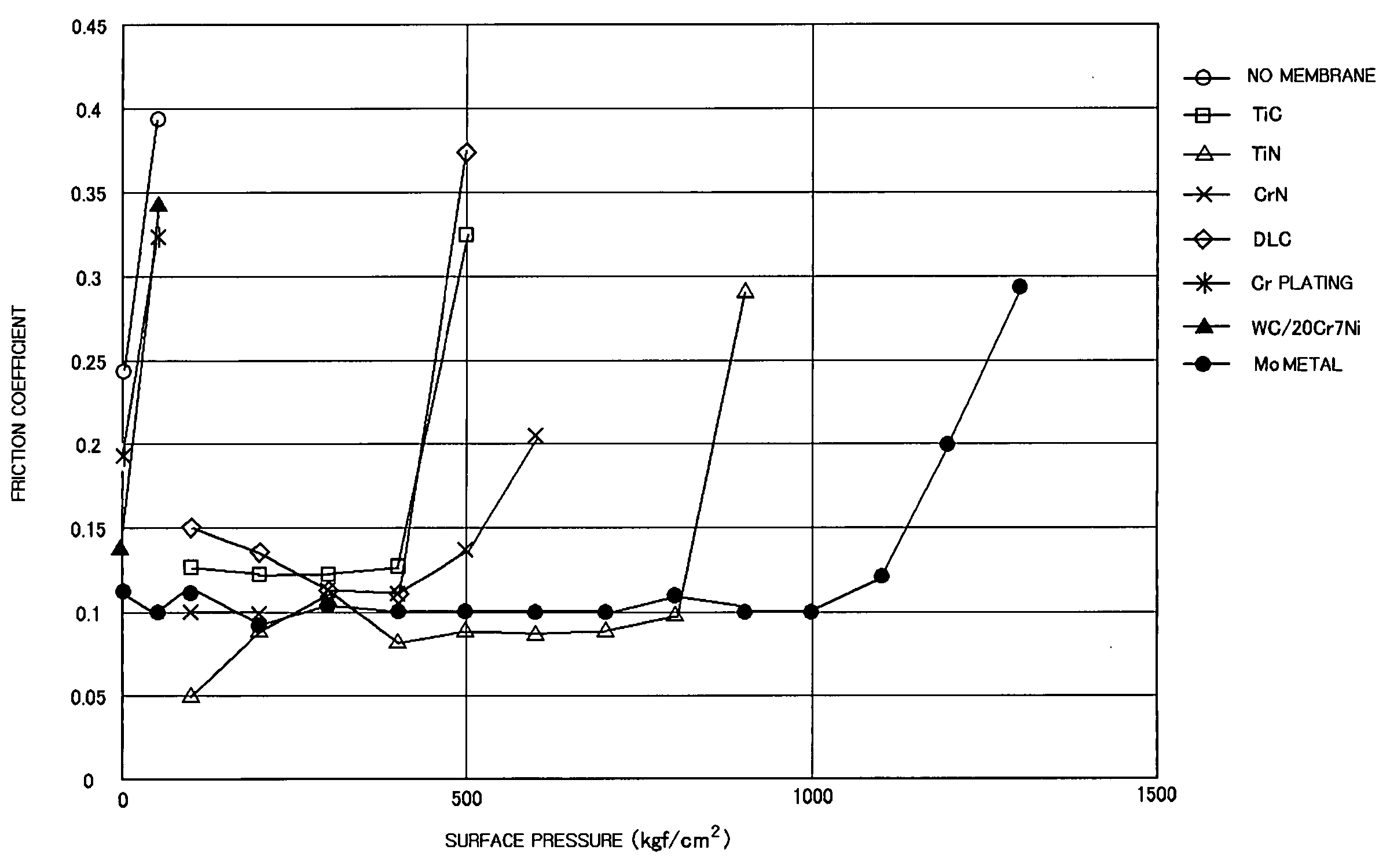Thermal spray membrane contact material, contact member and contact part, and apparatuses to which they are applied
- Summary
- Abstract
- Description
- Claims
- Application Information
AI Technical Summary
Benefits of technology
Problems solved by technology
Method used
Image
Examples
example 1
(EXAMPLE 1)
[0167] [Bearing Test 1: Evaluation of Various Hard Membrane of Multi-layer Bearing Axis]
[0168] In this example, a bearing test was conducted between various multi-layer bearing axes obtained by performing induction hardening and tempering (180° C.×1 hr, surface hardness: HRC 60) on the outer circumferential surface of a S55C bearing axis, and the bearing bushing (S45C ingot material) shown in FIG. 15, to check seizure resistant limit surface pressure of the various hard membrane materials. The above-mentioned various hard membranes are in total seven materials of TiC, TiN, CrN, DLC (diamond like-carbon), Cr plating, WC20Cr7Ni and Mo metal. On the inner circumferential surface (contact surface) of the bearing bushing, an induction hardening and tempering (160° C.×1 hr) treatment was performed, and the hardness of the inner circumferential surface was controlled to Hv600 (HRC 55). In this bearing test, various multi-layer bearing axes were swung at an average slipping speed...
example 2
(EXAMPLE 2)
[0172] [Bearing Test 2: Investigation of Alloy Phase in Thermal Spray Membrane]
[0173] In this example, Cu-10Sn, Cu-30Zn, Cu-63Zn, Fe-0.6C-7Al-22Cu alloy and Fe20Ni10Al alloy powder were compounded in amounts of 95, 90, 80, 70, 50, 20 and 5 wt %, in addition to Cu and Ni metals, into Mo metal to prepare a thermal spray mixed powder which was thermal-sprayed on the same bearing axis as in Example 1 to form a thermal spray membrane having a thickness of 0.2 mm. Various multi-layer bearing axes were thus obtained of which surface roughness had been controlled to 3 μm or less. 0.7 wt % of a graphite powder (average particle size: 6 μm, Ronza KS6) was mixed with a 4600 iron powder of #100 mesh or less to obtain a mixed powder, to this was added and mixed an organic lubricant (Acrawax) in an amount of 0.7 wt % and the mixture was molded under a molding pressure of 5 ton / cm2, then, subjected to vacuum sintering at 1150° C. for 2 hours, quenching with N2 gas, and a tempering treat...
example 3
(EXAMPLE 3)
Constant Speed Friction Wearing Test
[0175] In this example, the various thermal spray membrane materials handled in Example 2 in which the amount of the Mo metal phase was 3, 5, 10, 20, 30, 40 and 100 wt % in a Cu-10Sn alloy were thermal-sprayed on a contact surface of a specimen shown in FIG. 19, and the seizure resistance of the various thermal spray membrane materials was checked under a dropping lubrication condition by a constant friction wearing tester. Regarding the sliding test conditions, a carburization quenching and tempering treatment was performed on SCM415, and the surface hardness was controlled to HRC 60 and the surface roughness was controlled to 3 μm or less. Thus prepared rotation disc was rotated at a circumferential speed of 10 m / sec, while #10 engine oil heated at 60° C. was dropped at a rate of 5 cm3 / min on the front surface of the sliding specimen to lubricate this. During this procedure, the friction coefficient and the worn amount at this moment...
PUM
| Property | Measurement | Unit |
|---|---|---|
| surface pressure | aaaaa | aaaaa |
| kinematic viscosity | aaaaa | aaaaa |
| surface pressure | aaaaa | aaaaa |
Abstract
Description
Claims
Application Information
 Login to View More
Login to View More - R&D
- Intellectual Property
- Life Sciences
- Materials
- Tech Scout
- Unparalleled Data Quality
- Higher Quality Content
- 60% Fewer Hallucinations
Browse by: Latest US Patents, China's latest patents, Technical Efficacy Thesaurus, Application Domain, Technology Topic, Popular Technical Reports.
© 2025 PatSnap. All rights reserved.Legal|Privacy policy|Modern Slavery Act Transparency Statement|Sitemap|About US| Contact US: help@patsnap.com



